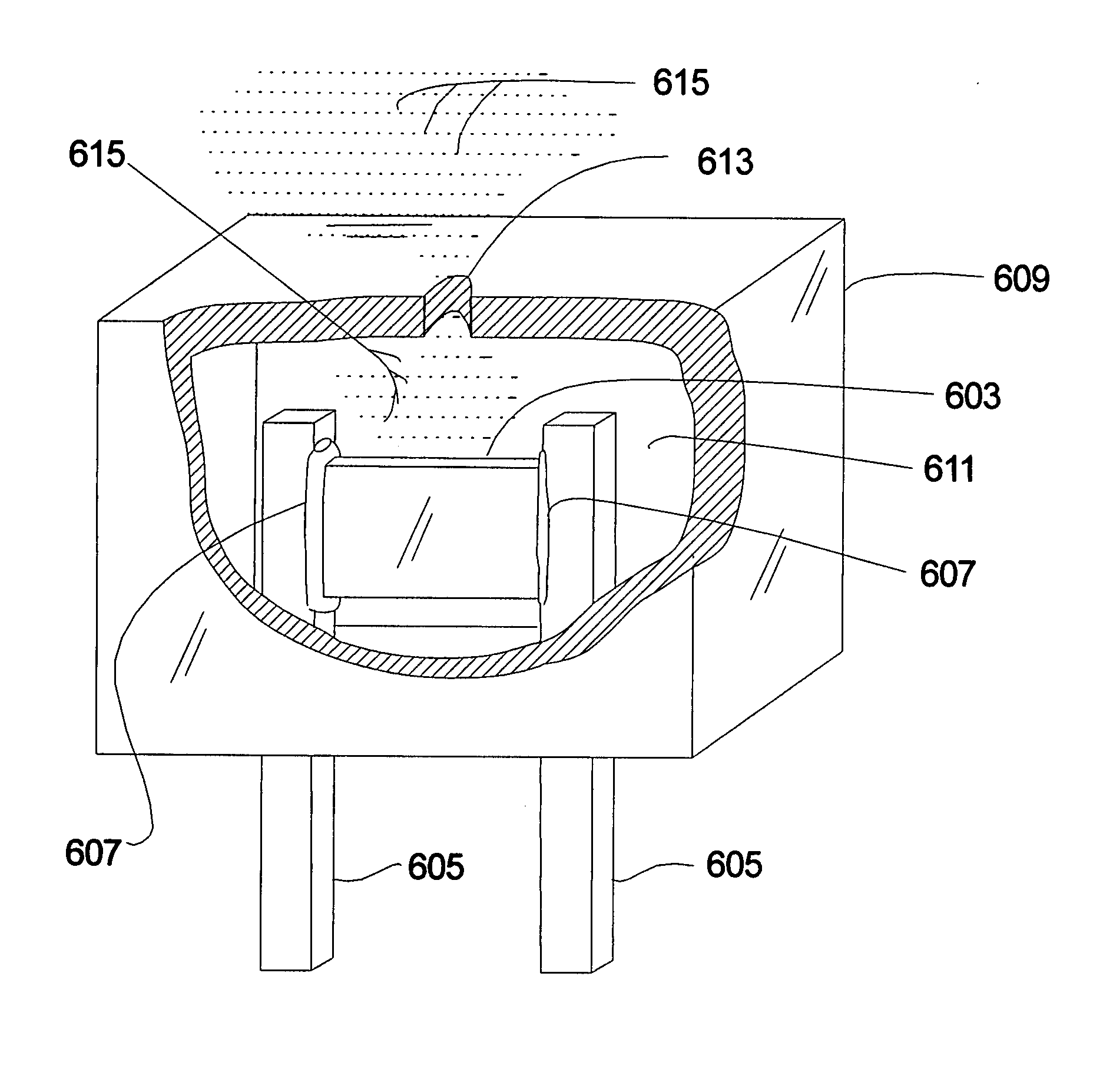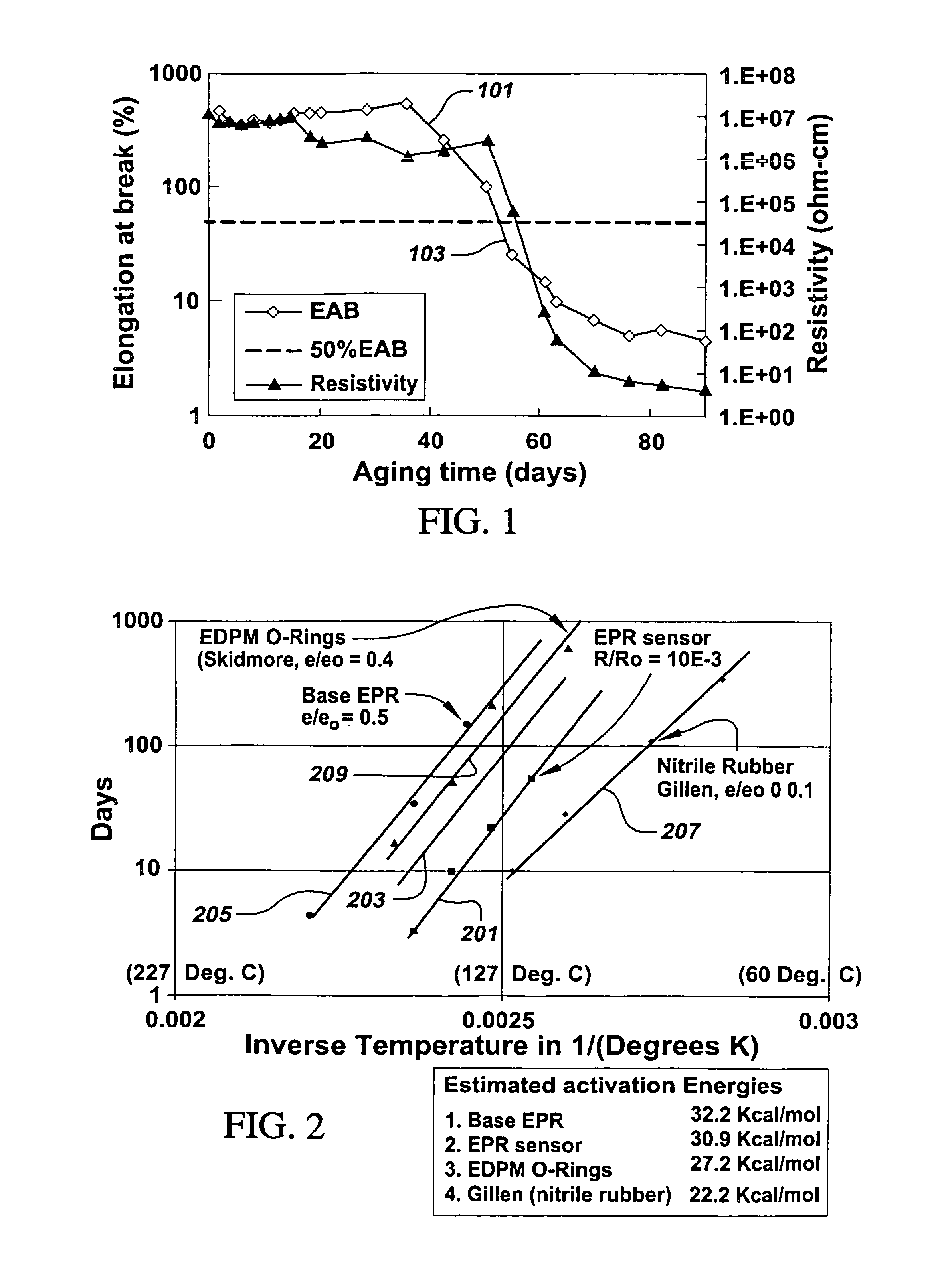Electrical sensor for monitoring degradation of products from environmental stressors
a technology of environmental stressors and sensors, applied in the direction of measuring objects on conveyors, instruments, testing food, etc., can solve the problems high cost, and high cost, and achieve the effect of reducing the risk of premature degradation of products for customers and health and safety
- Summary
- Abstract
- Description
- Claims
- Application Information
AI Technical Summary
Benefits of technology
Problems solved by technology
Method used
Image
Examples
example 1
[0071]FIG. 2 is an Arrhenius diagram showing correlation of a conductive composite degradation sensor 201 made by compounding ethylene propylene rubber (EPR) and carbon black. The carbon black loading was adjusted to provide an initial resistivity of approximately 1E+8 ohm-cm. Another sensor 203 was made by adding a commercial anti-oxidant. The samples were aged in a thermo-oxidative environment (convective oven) at several temperatures and plotted on the Arrhenius diagram. The times plotted for the degradation sensors corresponded to a relative decrease in resistivity (3 decade decrease from the initial resistivity). A plot of the same EPR base material 205 as used in the degradation sensor, but plotted conventionally by mechanical degradation (50% drop in elongation), is shown for comparison. Activation energies of the two sensors (with and without anti-oxidant measured by resistivity decrease) and the EPR base polymer (measured by loss of elongation) are similar and shown for com...
example 2
[0073]FIG. 3 is a resistivity vs. time chart for a degradation sensor made of a two-part epoxy (at several hardener / resin mixtures) thermoset material and a nickel conductive filler, aged at 60° C. FIG. 4 is a resistivity vs. time chart for a degradation sensor made of the two-part epoxy thermoset material and a nickel conductive filler, aged at 40° C. As the chemical crosslinking proceeds, volumetric shrinkage of the polymeric matrix increases the volume fraction of the conductive filler, causing the resistivity to decrease. Both trials utilized three specimens with different resin / hardener ratios. As seen from the charts, increasing hardener (control agent) percentage increases the rate of resistivity decrease, corresponding to an increased reaction rate (curing) of the epoxy. Increased temperature (environmental stressor) also increases the reaction rate, increasing the rate of decrease of resistivity and reducing the curing time of the epoxy.
example 3
[0074]FIG. 5 is a resistivity-time chart of a conductive composite sensor made utilizing a volatile polymeric component and silver particles. The composite utilized in this test is a commercially available conductive pen product (Chemtronics CT-CW2200STP). As can be seen from the figure, the reaction rate of resistivity decrease increases with temperature (environmental stressor).
[0075]Selecting the matrix polymer for a degradation sensor can be used to determine the overall activation energy of the sensor reaction. Selection of a rate-affecting component such as the type and amount of an anti-oxidant in an elastomer or thermoplastic, can be used to adjust the time constant (Y intercept of the Arrhenius curve) of the reaction. Or, the resin and hardeners types may be selected in thermoset polymer matrixes to provide a desired activation energy and the resin / hardener ratios selected to control the time constant of the reaction.
[0076]Still another method of “designing” a degradation s...
PUM
 Login to View More
Login to View More Abstract
Description
Claims
Application Information
 Login to View More
Login to View More - R&D
- Intellectual Property
- Life Sciences
- Materials
- Tech Scout
- Unparalleled Data Quality
- Higher Quality Content
- 60% Fewer Hallucinations
Browse by: Latest US Patents, China's latest patents, Technical Efficacy Thesaurus, Application Domain, Technology Topic, Popular Technical Reports.
© 2025 PatSnap. All rights reserved.Legal|Privacy policy|Modern Slavery Act Transparency Statement|Sitemap|About US| Contact US: help@patsnap.com



